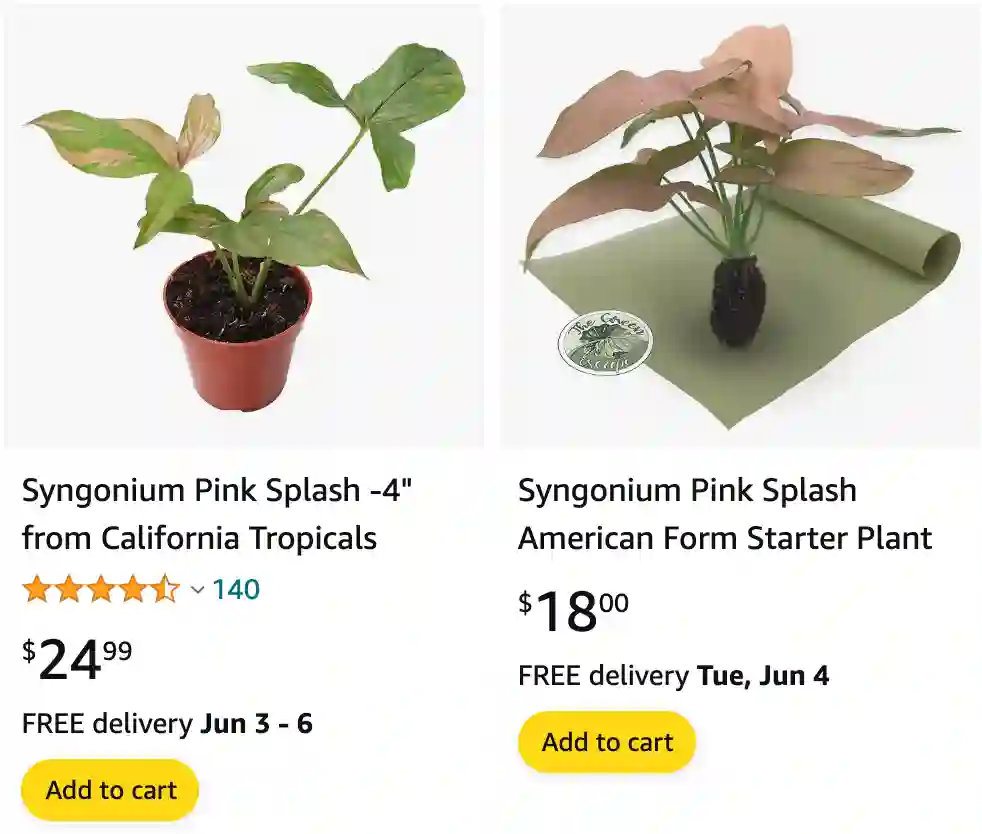
Discovering the Beauty of Syngonium Pink Splash
Hello, I’m Ferb Vu, and today I’d like to share with you my passion for a truly unique and captivating plant: the Syngonium Pink Splash. This delightful houseplant has quickly become a favorite among plant enthusiasts, including myself, thanks to its vibrant foliage and relatively easy care requirements. Whether you’re a seasoned gardener or a budding plant lover, Syngonium Pink Splash can add a splash of color and life to your indoor space.
What is Syngonium Pink Splash?
Syngonium Pink Splash, scientifically known as Syngonium podophyllum ‘Pink Splash,’ is a popular cultivar of the Syngonium genus. This plant is prized for its arrowhead-shaped leaves that boast stunning splashes of pink and cream against a backdrop of green. The variegation pattern on each leaf is unique, making every plant a little different and adding to its appeal.
Syngonium Pink Splash vs Confetti
My Syngonium Pink Splash is a stunner. The deep green leaves are like a canvas splashed with vibrant pink polka dots. The pink isn’t shy – it demands attention! It’s definitely a showier plant, perfect for adding a pop of color to any room. Don’t get me wrong, I love my Confetti Syngonium too. It has a more whimsical vibe. The light green leaves are speckled with a delicate light brown, like tiny freckles. It’s subtler, but the combination gives it a charming, speckled effect. While the Pink Splash makes a bold statement, the Confetti whispers a sweet melody.
Syngonium Pink Splash vs Pink Spot
Both my Pink Splash and Pink Spot have beautiful pink variegation, but they express it in very different ways. The Pink Splash is like a party – the pink dots are big, bold, and scattered all over the leaf. It’s a riot of color! Syngonium Pink Spot, on the other hand, is more reserved. The pink shows up in smaller patches, sometimes even just a hint along the edges. It feels more elegant, like a watercolor painting come to life. Personally, I find the Pink Splash’s boldness a bit overwhelming sometimes, while the Pink Spot’s delicate touch feels more sophisticated. It really depends on the look you’re going for!
How to Care for Syngonium Pink Splash?
Caring for a Syngonium Pink Splash is relatively straightforward, but there are some key points to keep in mind to ensure your plant thrives:
Light Requirements
Syngonium Pink Splash prefers bright, indirect light. Too much direct sunlight can scorch the leaves, while too little light can cause the pink variegation to fade. A spot near a window with filtered light is ideal.
Watering
Keep the soil consistently moist but not waterlogged. Water your Syngonium Pink Splash when the top inch of soil feels dry. Overwatering can lead to root rot, so make sure the pot has good drainage.
Humidity
This plant enjoys higher humidity levels, which can be achieved by misting the leaves regularly or placing a humidifier nearby. Alternatively, you can place the pot on a tray filled with pebbles and water to increase humidity around the plant.
Temperature
Syngonium Pink Splash thrives in temperatures between 60-80°F (16-27°C). Avoid placing it near drafts or sudden temperature changes.
Fertilizing
Feed your plant with a balanced liquid fertilizer every month during the growing season (spring and summer). Reduce feeding during the fall and winter months when the plant’s growth slows down.
How to Propagate Syngonium Pink Splash?
Propagating Syngonium Pink Splash is a rewarding process that allows you to create new plants from your existing one. Here’s how you can do it:
Stem Cuttings
- Choose a Healthy Stem: Select a healthy stem with at least one or two nodes (the points where leaves grow).
- Cut the Stem: Using a clean, sharp pair of scissors or pruning shears, cut the stem just below a node.
- Remove Lower Leaves: Strip the leaves from the lower part of the cutting, leaving a few leaves at the top.
- Place in Water or Soil: You can either place the cutting in a glass of water or directly into moist potting soil. If using water, change it every few days to keep it fresh.
- Wait for Roots to Develop: In a few weeks, roots should start to form. Once the roots are a few inches long, you can transplant the cutting into a pot with soil.
When does Pink Splash Syngonium get pink?
The pink variegation in Syngonium Pink Splash can vary based on several factors:
Light Exposure
Adequate light exposure is crucial for the development of the pink splashes. Bright, indirect light helps maintain and enhance the vibrant colors.
Maturity of the Plant
Younger leaves tend to show more variegation as they mature. Patience is key, as it may take some time for new growth to display its full spectrum of colors.
Seasonal Changes
The variegation can also be influenced by seasonal changes. During the growing season, you might notice more pronounced colors compared to the dormant period in fall and winter.
What to Plant with Syngonium Pink Splash?
Companion planting can enhance the visual appeal of your indoor garden. Consider pairing your Syngonium Pink Splash with plants that have contrasting leaf shapes and colors. Some good companions include:
- Philodendron Brasil: With its heart-shaped leaves and yellow variegation, it complements the pink tones of the Syngonium.
- Pothos: The variegated leaves of Pothos provide a nice contrast and are equally easy to care for.
- Spider Plant: The narrow, arching leaves of the Spider Plant create a dynamic visual effect when paired with the broader leaves of Syngonium.
Conclusion
Syngonium Pink Splash is a delightful addition to any indoor plant collection. Its vibrant foliage and relatively easy care requirements make it a favorite among plant enthusiasts. By following the care and propagation tips shared here, you can enjoy the beauty of this plant and even share it with friends and family. Happy gardening!




